by Lisa Cooke | Aug 20, 2016 | 01 What's New, DNA, Societies |

The Daughters of the American Revolution (DAR) accepts limited DNA evidence to prove descent from a Revolutionary War veteran. In my opinion, the DAR DNA policy is a little too limited. Here’s why–and what you can do.
Membership to the Daughters of the American Revolution (DAR) has been a holy grail for U.S. genealogists for 125 years. With its requirement of proof of a “lineal bloodline descendant from an ancestor who aided in achieving American independence” in three categories: birth, marriage, and death, as well as proof of Revolutionary War Service, membership is exclusive to those with an iron-clad paper trail.
That is, until 2014, when the DAR added DNA evidence to its list of acceptable documents proving a relationship to a Revolutionary War ancestor.
What does the DAR DNA Policy Accept?
The DAR only accepts one of the three forms of DNA testing which is the Y chromosome test, or YDNA. The YDNA traces only a direct paternal line, making it a great choice when trying to link living males with their Revolutionary counterparts. This YDNA is basically passed unchanged from generation to generation, making the modern day holder of the YDNA the proud owner of possibly exactly the same YDNA that fought the Redcoats. That’s pretty cool, don’t you think?
The DAR recently announced that to further help those wanting to use their YDNA as part of their application, they have formed a project at Family Tree DNA, the company that provides the YDNA testing. Projects are absolutely the best way to get the most out of your YDNA testing. There are surname projects, location projects, haplogroup (deep ancestral group) projects, and even special interest group projects, such as this one for the DAR.
While the results of the testing are only available to members of the group, the statistics page gives us an idea of the scope of this project. They currently have 1,242 total members and what looks to be about 430 YDNA tests completed (though it is admittedly difficult to tell based on the chart online.) This means if you think your paternal line may be a candidate for the DAR, you can have a representative of your line tested and compared to the group. If you find a match, you will have relative certainty that you do connect to that Patriot, and can then be more confident in your traditional research in pursuit of the necessary paper connections.
In April the DAR opened up project membership to include mtDNA and autosomal DNA. They will not be using these two kinds of DNA in their applications (yet), but hopefully this project will pave the way for the addition of those tests in the future (though, for several reasons, inclusion of these tests in the application process will be more difficult.)
Though, in all honesty, they have made the YDNA process difficult enough. Let’s say that you are actually able to trace down multiple generations to find a direct male descendant of your Revolutionary guy to be tested, an individual who is, the DAR mandates, “sharing your maiden name or your mother’s maiden name,” and you convince that unassuming relative to give up his saliva, you still are only half way there. The DAR guidelines also state that you have to have a second individual who is “a descendant of the same Revolutionary War ancestor through a different unbroken male lineage that has been previously proven on a DAR application…” (I added the emphasis here.)
A Practical Example of the DAR DNA Policy
OK, so let’s say you are a genealogical whiz and, let’s face it, you were lucky, and you find two such candidates and have them tested.
Well, the DAR tells us that those two men must match EXACTLY on the 37 YDNA markers tested. Now there is no telling when that YDNA might experience a mutation. So to me it seems a little unfair to require perfection. So it is possible, that even after all the work of finding the right guys to be tested, the test itself may work against you, as even one difference is enough to keep this YDNA off of your application, at least for now.
So while I applaud the DAR for using YDNA testing at all, and for spearheading a special interest project at Family Tree DNA, the reality is that the limitations of direct paternal line genealogy and the requirements of testing make it unlikely that very many will be able to take advantage of the YDNA in their DAR applications.
However, there are a few things you can take away from this article now:
- First, collect those DNA samples whenever you can, especially for key relatives, like your paternal line and the oldest living generation (whose DNA is less likely to have experienced any mutation.)
- Second, keep your research paper trail strong. Nothing in the near future of the genetic genealogy industry tells us that distant relative connections (like to your Revolutionary War ancestor) will be provable by DNA alone.
- And third, definitely look at crowd-sourced studies for your particular DNA. Those surname, location, haplogroup, and special interest group projects I mentioned from FTDNA are just some of the ones that might help your research—or that you could use to help someone else’s. I’ve talked about these studies before: click here to read about them.
My Complete DNA for Genealogy Research Guide Series
I am Diahan Southard, Your DNA Guide, and the author of a series of genetic genealogy quick guides. My guide called Y Chromosome DNA for the Genealogist is the perfect tool to help guide you through the testing and analysis process. Click here to learn more about this guide and here for all of my guides, or click here to learn more about my series of how-to videos, also available to Gems fans for a special price.
Thanks for sharing this post with your genealogy friends who do DNA research (especially those who may have Revolutionary War ancestors!)
by Lisa Cooke | Aug 1, 2016 | 01 What's New, DNA
“Are unassigned DNA test kits interchangeable? Does Diahan Southard do one-on-one DNA consultations for genealogy?” A listener asks, and we have the answers.
Simona recently wrote in with compliments and two questions for Diahan Southard. Here’s the Q&A, on more resources from Diahan AND whether DNA test kits from Family Tree DNA are interchangeable if they haven’t been use:
Q: “No one, I mean NO one makes DNA easier and more interesting than…your DNA expert Diahan does! I am curious as to what Diahan charges for phone or email consults regarding who to test for what.”
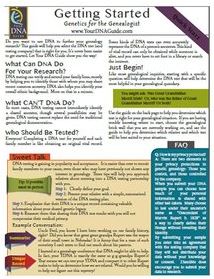 A: Yes, I agree, Diahan Southard, Your DNA Guide and the resident Genealogy Gems genetics expert, is amazing! Diahan answers a lot of those initial question about who to test for what in her handy Getting Started: Genetics for the Genealogist Quick Guide (click to view/purchase). It’s very affordable and can give you inexpensive answers without needing to pay for one-on-one consultation.
A: Yes, I agree, Diahan Southard, Your DNA Guide and the resident Genealogy Gems genetics expert, is amazing! Diahan answers a lot of those initial question about who to test for what in her handy Getting Started: Genetics for the Genealogist Quick Guide (click to view/purchase). It’s very affordable and can give you inexpensive answers without needing to pay for one-on-one consultation.
That said, Diahan does offer DNA consultation services. She also teaches a series of how-to videos that’s, again, much more affordable than a consultation (and much more affordable than taking the wrong test or staring at your results afterward with NO idea what to do with them next). Like Simona says, Diahan demystifies DNA like no else does, and these video tutorials are no exception.
Genealogy Gems listeners get a discount on her video series. A year’s access to is regularly $39.95, but Gems listeners can click on a special link to get it for just $24.95. Click here to learn more.
Q: “I have 5 FamilyTree DNA kits on the counter. Are they all the same kits in the raw? I intended them for a Mtdna test, a Y test and 3 autosomal tests for various family folk. Can I switch tests and persons at this stage?”
A: Diahan says: “Yes, the Family Tree DNA kits she has can be used for any test, provided you correlate everything with the customer service team at FTDNA and get all the kit numbers changed to the appropriate tests.
Diahan Southard is definitely a valuable “GEM” here at Genealogy Gems. Whether you’re just starting to learn about DNA testing for genealogy research, or you’re trying to get the most out of your results, click here to read tons of free DNA how-tos and advice from Diahan. And thanks for sharing this post with your friends and genealogy buddies!This is so, so important as I know of too many women who have mistakenly used their husband’s YDNA kit number and had their sample run, which won’t produce any results. But FTDNA still ran the test, which means you still pay for it. So be EXTRA careful to make sure you have all of your ducks in a row.”
by Lisa Cooke | Apr 24, 2014 | 01 What's New, Google, Maps
Google Maps Street View was given an edge today over Google Earth’s street view when Google launched a “time travel” upgrade. The ability to time travel is high on most family historians list, and Street View imagery for Google Maps desktop provides a taste of that prize.
According to Google’s blog post today they have “gathered historical imagery from past Street View collections dating back to 2007 to create this digital time capsule of the world.”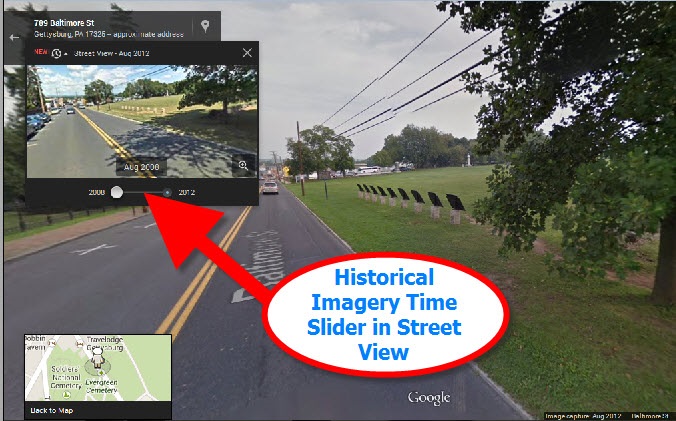 Here’s an example of viewing Gettysburg with the new feature. In many cases, there’s nothing earth shattering to see. But in some locations which have undergone substantial change in that short time period (such as viewing the reconstruction after the devastating 2011 earthquake and tsunami in Onagawa, Japan) the results are riveting.
Here’s an example of viewing Gettysburg with the new feature. In many cases, there’s nothing earth shattering to see. But in some locations which have undergone substantial change in that short time period (such as viewing the reconstruction after the devastating 2011 earthquake and tsunami in Onagawa, Japan) the results are riveting.
Don’t worry if you don’t see Google Maps Street View Historical Imagery feature yet. When you have millions of users it can take a while to roll out upgrades.
Members Have Been Time Traveling for a While Now
If you’re a Genealogy Gems Premium Member then chances are you made a bee-line for the Time Travel with Google Earth premium video as soon as you joined. In that video we explore some incredibly powerful ways to travel back through our ancestor’s lives and times. And while I still think that those techniques deliver more relevant results for genealogists, this new Street View time travel in Google Maps is exciting in its own way. It offers a glimpse into the future.
Consider this: Google has been amassing incredible amounts of data over its short life including satellite and street view imagery. 7 years in and they can now begin to offer this collection of older imagery in a meaningful way. Imagine what historical street view imagery will look like in 10, 25, or 50 years from now!
After Looking Back in Time, I Offer This Prediction for the Future
While this feature has just rolled out in Google Maps, and is not yet available in our beloved Google Earth, I predict this omission will not last long. You may have already noticed that as you zoom in closer to street level in Google Earth a small clock icon appears at the bottom of the screen indicating historical satellite imagery is available. Next to the icon a date now appears indicating the earliest available imagery. Click the Historical Imagery icon in Google Earth’s toolbar and a time slider indicating the years available will appear.
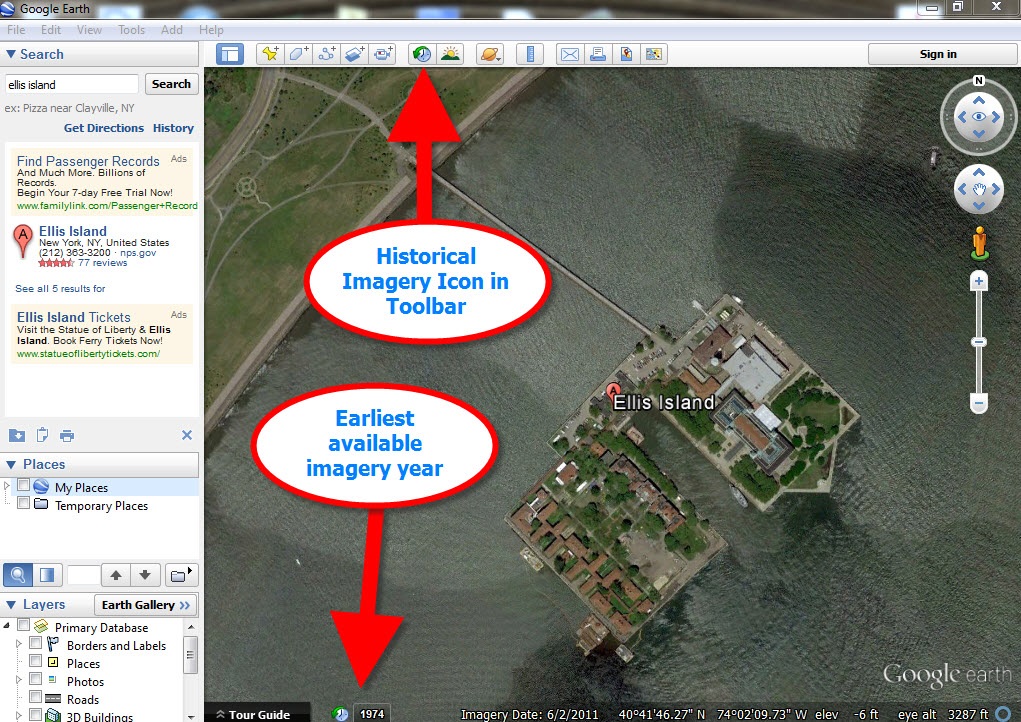
For most areas of the world this spans about as long as satellite imagery has been around. But in some key areas, such as London and parts of Europe, the slider goes back to the World War II era. Black and white aerial imagery of war torn areas are plainly visible. (If you have World War II veterans in your family tree, this is a feature you’ll want to explore.) It can only be a matter of time before this same Historical Imagery comes to Google Earth’s Street View.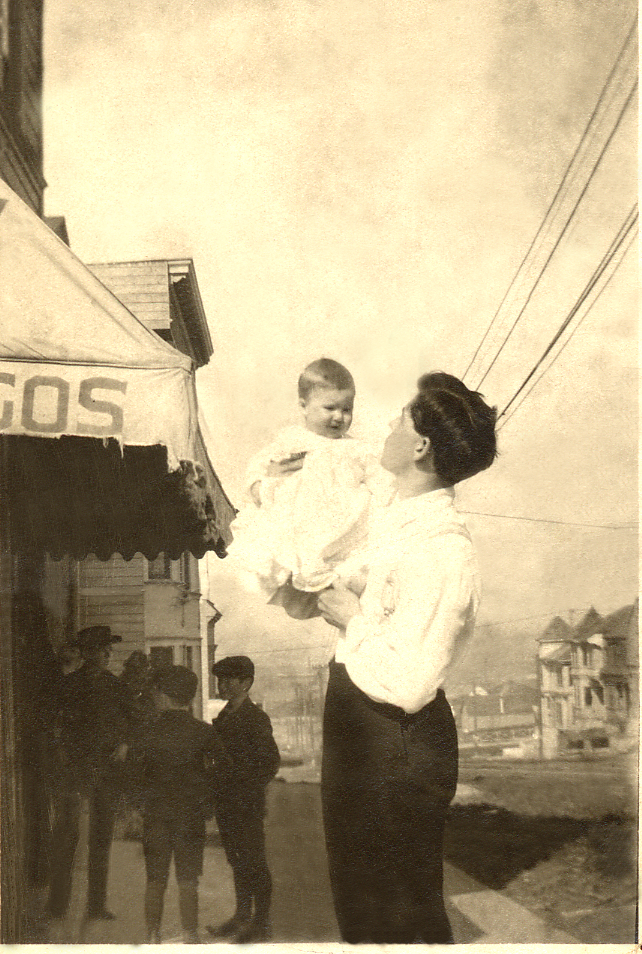 More Ways to Explore and Time Travel Now
More Ways to Explore and Time Travel Now
If you are intrigued by the idea of using this technology to simulate your own genealogical time travel experience, watch my free video called Google Earth for Genealogy. You’ll travel along with me as I uncover the secrets of a photograph taken just over one hundred years ago, pinpoint the location today, and then travel back in time to further explore my ancestor’s neighborhood. From there, the sky is the limit with Google Earth and Google Maps!
Further Reading:
by Lisa Cooke | Jan 16, 2017 | 01 What's New, DNA
Organize DNA matches with this innovative approach. If you are feeling overwhelmed with your DNA results, you are not alone. Learning to organize your DNA matches in an effective way will not only keep your head from spinning, but will help you hone in on possible matches that will break down brick walls. Here’s the scoop from Your DNA Guide, Diahan Southard.

I can tell whose turn it was to unload the dishwasher by the state of the silverware drawer. If either of the boys have done it (ages 13 and 11,) the forks are haphazardly in a jumble, the spoon stack has overflowed into the knife section, and the measuring spoons are nowhere to be found. If, on the other hand, it was my daughter (age 8,) everything is perfectly in order. Not only are all the forks where they belong, but the small forks and the large forks have been separated into their own piles and the measuring spoons are nestled neatly in size order.
Organize Your Imaginary DNA Drawer
Regardless of the state of your own silverware drawer, it is clear that most of us need some sort of direction to effective organize DNA matches. It entails more than just lining them up into nice categories like Mom’s side vs. Dad’s side, or known connections vs. unknown connections. To organize DNA matches, you really need to make a plan for their use. Good organization for your test results can help you reveal or refine your genealogical goals and help determine your next steps.
Step 1: Download your raw data. The very first step is to download your raw data from your testing company and store it somewhere on your own computer. See these instructions on my website if you need help.
Step 2: Identify and organize DNA matches. Now, we can get to the match list. One common situation for those of you who have several generations of ancestors in the United States, is that you may have ancestors that seem to have produced a lot of descendants. These descendants may have caught the DNA testing vision and this can be like your overflowing spoon stack! All these matches may be obscuring some valuable matches. Identifying and putting those known matches in their proper context can help you identify the valuable matches that may lead to clues about the descendant lines of your known ancestral couple.
In my Organizing Your DNA Matches quick sheet, I outline a process for identifying and drawing out the genetic and genealogical relationships of these known connections. Then, it is easier to verify your genetic connection is aligned with your genealogy paper trail and spot areas that might need more research.
This same idea of plotting the relationships of your matches to each other can also be employed as you are looking to break down brick walls in your family tree, or even in cases of adoption. The key to identifying unknowns is determining the relationships of your matches to each other.
Step 3: See the relationship between genetics, surnames, and locations. Another helpful tool is a trick I learned from our very own Lisa Louise Cooke–that is Google Earth. Have you ever tried to use Google Earth to help you in your genetic genealogy? Remember, the common ancestor between you and your match has three things that connect you to them: their genetics, surnames, and locations. We know the genetics is working because they show up on your match list. But often times you cannot see a shared surname among your matches. By plotting their locations in the free Google Earth, kind of like separating the big forks from the little forks, you might be able to recognize a shared location that would identify which line you should investigate for a shared connection.
So, what are you waiting for? Line up those spoons and separate the big forks from the little forks! Your organizing efforts may just reveal a family of measuring spoons, all lined up and waiting to be added to your family history.
More on Working with DNA Matches
How to Get Started with Using DNA for Family History
Confused by Your AncestryDNA Matches? Read This Post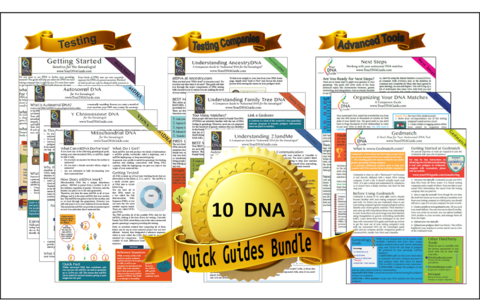
New AncestryDNA Common Matches Tool: Love It!







